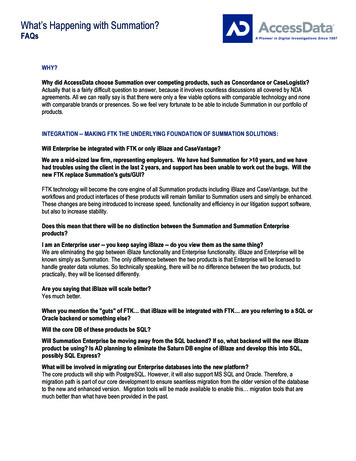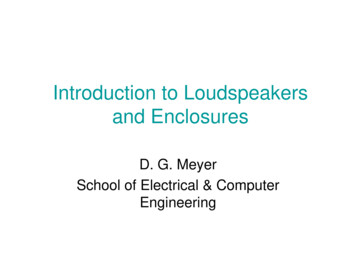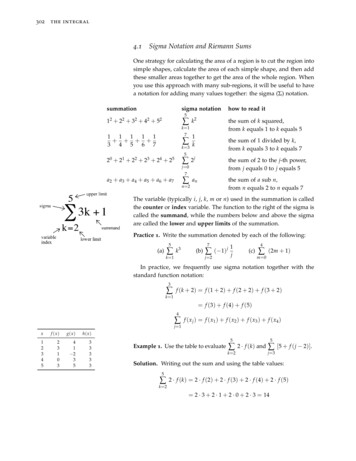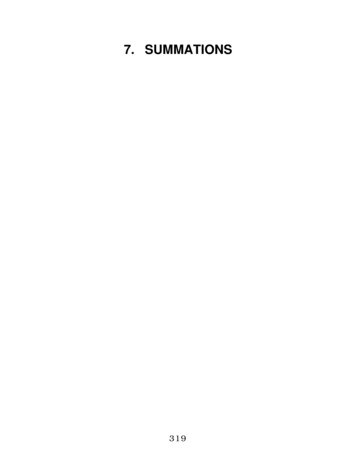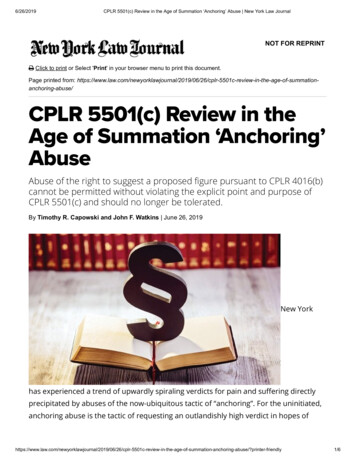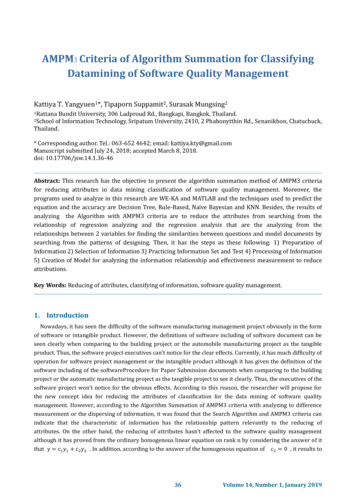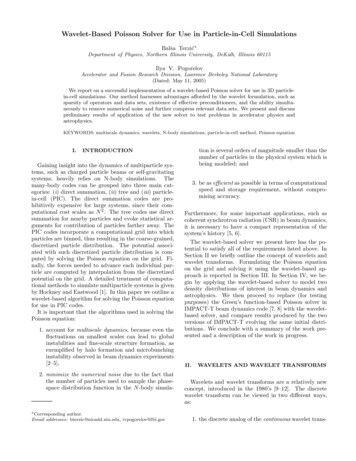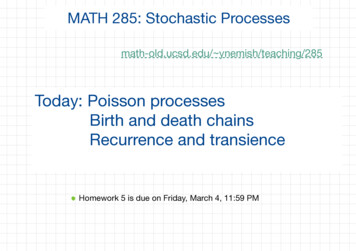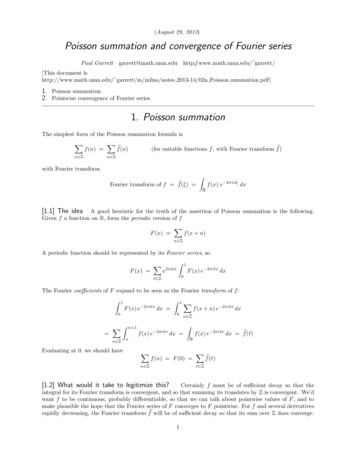
Transcription
(August 29, 2013)Poisson summation and convergence of Fourier seriesPaul Garrett tt/[This document ishttp://www.math.umn.edu/ garrett/m/mfms/notes 2013-14/02a Poisson summation.pdf]1. Poisson summation2. Pointwise convergence of Fourier series1. Poisson summationThe simplest form of the Poisson summation formula isXf (n) n ZXfb(n)(for suitable functions f , with Fourier transform fb)n Zwith Fourier transformZf (x) e 2πixξ dxFourier transform of f fb(ξ) R[1.1] The ideaA good heuristic for the truth of the assertion of Poisson summation is the following.Given f a function on R, form the periodic version of fF (x) Xf (x n)n ZA periodic function should be represented by its Fourier series, soXF (x) e1Z2πi xF (x) e 2πi x dx0 ZThe Fourier coefficients of F expand to be seen as the Fourier transform of f :Z1F (x) e 2πi xZ0 0XZn Z1Xdx n Zn 1f (x) e 2πi xZdx nf (x n) e 2πi x dxf (x) e 2πi x dx fb( )REvaluating at 0, we should haveXf (n) F (0) n ZXfb( ) Z[1.2] What would it take to legitimize this?Certainly f must be of sufficient decay so that theintegral for its Fourier transform is convergent, and so that summing its translates by Z is convergent. We’dwant f to be continuous, probably differentiable, so that we can talk about pointwise values of F , and tomake plausible the hope that the Fourier series of F converges to F pointwise. For f and several derivativesrapidly decreasing, the Fourier transform fb will be of sufficient decay so that its sum over Z does converge.1
Paul Garrett: Poisson summation and convergence of Fourier series (August 29, 2013)A simple sufficient hypothesis for convergence is that f be in the Schwartz space of infinitely-differentiablefunctions all of whose derivatives are of rapid decay, that is,Schwartz space {smooth f : sup (1 x2 ) f (i) (x) for all i, }xRepresentability of a periodic function by its Fourier series is a serious question, with several possible senses.The following section gives a result sufficient for the moment.2. Pointwise convergence of Fourier seriesA special, self-contained argument gives a good-enough result for immediate purposes. [1]Consider (Z-)periodic functions on R, that is, complex-valued functions f on R such that f (x n) f (x)for all x R, n Z. For periodic f sufficiently nice so that integralsZ1fb(n) f (x) e 2πinx dx(nth Fourier coefficient of f )0make sense, the Fourier expansion of f isXfb(n) e2πinx(Fourier expansion of f )n ZWe want simple sufficient conditions on f and on points xo so thatXf (xo ) fb(n) e2πinxo(as convergent double sum of complex numbers)n ZConsider periodic piecewise-C o [2] functions which are left-continuous and right-continuous [3] at anydiscontinuities.[2.0.1] Theorem: For periodic f piecewise-C o functions left-continuous and right-continuous at itsdiscontinuities, for points xo at which f is C 0 and left-differentiable [4] and right-differentiable, the Fourierseries of f evaluated at xo converges to f (x):Xf (xo ) fb(n) e2πinxon Z[1] The virtue of the argument here is mainly its immediacy and lack of prerequisites. However, this approach isinadequate in most other situations. For example, for many purposes, we want not mere pointwise convergence, butuniform pointwise convergence.[2] A function is piecewise-C o when it is C o except for a discrete set of points, at which it may fail to be continuous.[3] As usual, a function has a left-continuous at x if the limit of f (x) as x approaches x from the left exists.ooSimilarly, f is right-continuous if the limit approaching from the right exists. Note that there is no purpose in askingwhether these limits are the value f (xo ), since if they had that common value, then the function would be continuousat xo , and the notion of one-sided continuity would be irrelevant.[4] As usual, a function f is left-differentiable at x if the limit of [f (x) f (x )]/[x x ] exists as x approaches xoooofrom the left. Right-differentiability at xo is similar. Admittedly, this is a clumsy notion, but is relevant to treatmentof functions that are not entirely smooth, but not too badly behaved.2
Paul Garrett: Poisson summation and convergence of Fourier series (August 29, 2013)That is, for such functions, at such points, the Fourier series represents the function pointwise.[2.0.2] Remark: The most notable missing conclusion in the theorem is uniform pointwise convergence.For more serious applications, pointwise convergence not known to be uniform is often useless.Proof: First, treat the special case xo 0 and f (0) 0. Representability of f (0) by the Fourier series isthe assertion that0 f (0) XlimM,N fb(n) e2πin·0 M n NXlimM,N fb(n) M n NSubstituting the defining integral for the Fourier coefficients:X M n NZ1 X1ZXfb(n) f (u) e 2πinu du M n N0Z1f (u) e 2πinu du 0 M n Nf (u) ·0e2πiM u e 2πiN udu1 e 2πiuTo prove the representability of f (0) by the Fourier series, we will show thatZlim 01f (u) · e 2πi udu 01 e 2πiuWe claim that the functiong(x) f (x)1 e 2πixis piecewise-C o , and left-continuous and right-continuous at discontinuities. The only issue is at integers,and by the periodicity it suffices to prove continuity at 0. To prove continuity at 0, we can forget aboutperiodicity for a moment, and writef (x)f (x)x ·1 e 2πixx1 e 2πixThe two-sided limitxd 2πixx 0 1 edxlimx x 0 1 e 2πixexists, by differentiability. Similarly, we have left and right limitslim f (x) left derivative at 0xlimf (x) left derivative at 0xx 0andx 0 by the one-sided differentiability of f . Combining these two one-sided limits, both limitslimx 0 f (x)1 e 2πixlimx 0 f (x)1 e 2πixexist, proving the one-sided continuity of g at 0.We want to prove an easy instance of a Riemann-Lebesgue lemma, namely, that that the Fourier coefficientsof a periodic, piecewise-C o function g, with left and right limits at discontinuities, go to 0.3
Paul Garrett: Poisson summation and convergence of Fourier series (August 29, 2013)The essential property of g is that on [0, 1] it is approximable by step functions [5] in the sense [6] that, givenε 0 there is a step function s(x) such that1Z s(x) g(x) dx ε0With such s,Z bs(n) gb(n) 1 s(u) g(u) du ε(for all ε 0)0Thus, it suffices to prove that Fourier coefficients of step functions go to 0, and, thus, that Fourier coefficientsof characteristic functions of intervals go to 0. The latter is an easy computation:Zbe 2πi x dx [ae 2πi x be 2πi b e 2πi a]a 0 2πi 2πi (as )This proves a RIemann-Lebesgue lemma for any function L1 -approximable by step functions. Thus, theFourier coefficients of g go to 0, proving that the Fourier series of f converges to f (0) when f is C 1 at 0.For arbitrary xo [0, 1], replacing f by f f (xo ) reduces to the case that f (xo ) 0. Note that the continuityof f at xo is necessary for this reduction. Replacing f (x) by ϕ(x) f (x xo ) reduces to the case xo , notingthat the effect on the Fourier expansion is to multiply the Fourier coefficients by constants:Z 1Z 1 xoZ 1 xoϕ(n)b f (x xo ) e 2πinx dx f (x) e 2πin(x xo ) dx e2πinxof (x) e 2πinx dx0xoxoFor any Z-periodic function h, using the periodicity, such a shifted integral can be converted back to anintegral over [0, 1]:Z1 xoZ1h(x) dx Z1 xoh(x) dx xoxoZh(x) dx 1 xoxoZh(x) dx xoZh(x) dx 1Z1Zh(x) dx 0xoh(x 1) dx01h(x) dx0Thus,ϕ(n)b e2πinxoZ1 xof (x) e 2πinx dx e2πinxoxo1Zf (x) e 2πinx dx e2πinxo fb(n)0Thus, the result at xo 0 for ϕ(x) f (x xo ) gives the general case:XXf (xo ) ϕ(0) ϕ(n)b fb(n) e2πinxonn[5] As usual, a step function ϕ is a function that assumes only finitely-many values, and is of the form y1 y 2.ϕ(x) yk 1 yk(for x0 x x1 )(for x1 x x2 )(for xk 2 x xk 1 )(for xk 1 x xk )for some collection of intervals [x0 , x1 ), [x1 , x2 ), . . . , [xk 1 ) and corresponding values y1 , . . . , yk .[6] In standard language, this assertion of approximability is that continuous functions on [0, 1] can be approximatedby step functions in L1 -norm. The L1 norm f L1 of a function on [0, 1] is simply the integral of the absolute value:R10 f (x) dx.4
Paul Garrett: Poisson summation and convergence of Fourier series (August 29, 2013)Thus, we have proven that piecewise-C 1 functions with left and right limits at discontinuities are pointwiserepresented by their Fourier series at points where they’re differentiable.///[2.0.3] Remark: In fact, the argument above shows that for a function f and point xo such thatf (x) f (xo )e2πix e2πixois in L1 [0, 1], the Fourier series at xo converges to f (xo ). This holds, for example, when f satisfies a Lipschitzcondition f (x) f (xo ) x xo α(as x xo , with some α 0)and is in L1 [0, 1].5
1. Poisson summation The simplest form of the Poisson summation formula is X n2Z f(n) X n2Z fb(n) (for suitable functions f, with Fourier transform fb) with Fourier transform Fourier transform of f fb( ) Z R f(x) e 2ˇix dx [1.1] The idea A good heuristic for the truth of the assertion of Poisson summation is the following.


